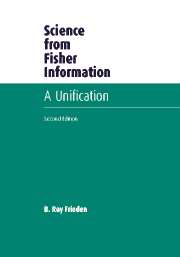Book contents
- Frontmatter
- Contents
- 0 Introduction
- 1 What is Fisher information?
- 2 Fisher information in a vector world
- 3 Extreme physical information
- 4 Derivation of relativistic quantum mechanics
- 5 Classical electrodynamics
- 6 The Einstein field equation of general relativity
- 7 Classical statistical physics
- 8 Power spectral 1 / ƒ noise
- 9 Physical constants and the 1/x probability law
- 10 Constrained-likelihood quantum measurement theory
- 11 Research topics
- 12 EPI and entangled realities: the EPR–Bohm experiment
- 13 Econophysics, with Raymond J. Hawkins
- 14 Growth and transport processes
- 15 Cancer growth, with Robert A. Gatenby
- 16 Summing up
- Appendix A Solutions common to entropy and Fisher I-extremization
- Appendix B Cramer–Rao inequalities for vector data
- Appendix C Cramer–Rao inequality for an imaginary parameter
- Appendix D EPI derivations of Schrödinger wave equation, Newtonian mechanics, and classical virial theorem
- Appendix E Factorization of the Klein–Gordon information
- Appendix F Evaluation of certain integrals
- Appendix G Schrödinger wave equation as a non-relativistic limit
- Appendix H Non-uniqueness of potential A for finite boundaries
- Appendix I Four-dimensional normalization
- Appendix J Transfer matrix method
- Appendix K Numerov method
- References
- Index
7 - Classical statistical physics
Published online by Cambridge University Press: 03 February 2010
- Frontmatter
- Contents
- 0 Introduction
- 1 What is Fisher information?
- 2 Fisher information in a vector world
- 3 Extreme physical information
- 4 Derivation of relativistic quantum mechanics
- 5 Classical electrodynamics
- 6 The Einstein field equation of general relativity
- 7 Classical statistical physics
- 8 Power spectral 1 / ƒ noise
- 9 Physical constants and the 1/x probability law
- 10 Constrained-likelihood quantum measurement theory
- 11 Research topics
- 12 EPI and entangled realities: the EPR–Bohm experiment
- 13 Econophysics, with Raymond J. Hawkins
- 14 Growth and transport processes
- 15 Cancer growth, with Robert A. Gatenby
- 16 Summing up
- Appendix A Solutions common to entropy and Fisher I-extremization
- Appendix B Cramer–Rao inequalities for vector data
- Appendix C Cramer–Rao inequality for an imaginary parameter
- Appendix D EPI derivations of Schrödinger wave equation, Newtonian mechanics, and classical virial theorem
- Appendix E Factorization of the Klein–Gordon information
- Appendix F Evaluation of certain integrals
- Appendix G Schrödinger wave equation as a non-relativistic limit
- Appendix H Non-uniqueness of potential A for finite boundaries
- Appendix I Four-dimensional normalization
- Appendix J Transfer matrix method
- Appendix K Numerov method
- References
- Index
Summary
Goals
Classical statistical physics is usually stated in the non-relativistic limit, and so we restrict ourselves to this limit in the analyses to follow. However, as usual, we initiate the analysis on a covariant basis.
The overall aim of this chapter is to show that many classical distributions of statistical physics, defining both equilibrium and non-equilibrium scenarios, follow from a covariant EPI approach. Such equilibrium PDFs as the Boltzmann law on energy and the Maxwell–Boltzmann law on velocity will be derived. Non-equilibrium PDFs on velocity will also be found. Finally, some recently discovered inequalities linking entropy and Fisher information will be derived.
Covariant EPI problem
Physical scenario
Let a gas be composed of a large number M of identical molecules of mass m within a container. The temperature of the gas is kept at a constant value T. The molecules are randomly moving and mutually interacting through forces due to potentials. The particles randomly collide with themselves and the container walls. All such collisions are assumed to be perfectly elastic. The mean velocity of any particle over many samples is zero.
The overall goal is to find the probability laws governing the energy E and momentum μ fluctuations of an arbitrary particle of the gas, at an arbitrary time t. The value of t is not necessarily large, so the gas is not necessarily at equilibrium. Consequently we seek general non-equilibrium probability laws.
An alternative EPI approach to the one to be taken here is given in Chapter 13. It is called the “macroscopic approach” (of MFI in Sec. 1.8.8) and is briefly discussed in this paragraph.
- Type
- Chapter
- Information
- Science from Fisher InformationA Unification, pp. 209 - 242Publisher: Cambridge University PressPrint publication year: 2004



